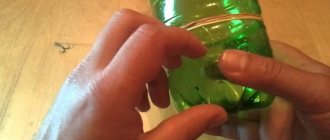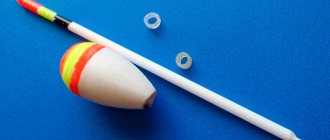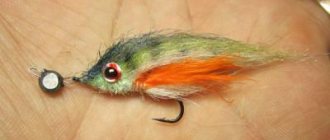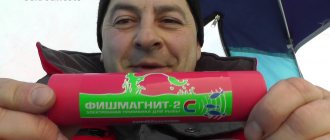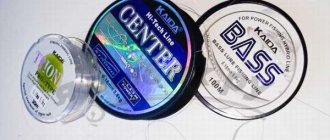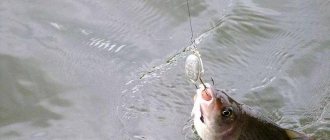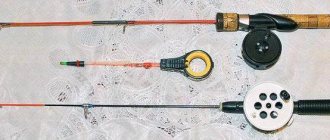Homemade fishing screen - easy and simple!
A good fisherman has in his arsenal many types of gear, baits and other components for any fishing season. In addition, any professional fisherman needs to have in his fishing gear a fishing device such as a fishing screen. Many fishermen have been familiar with it since early childhood. It is easy to make and does not require large investments to make it. Since not all fishermen have enough finances to buy it in a fishing store, let's see how you can make a homemade fishing screen, or, as it is otherwise called, a fishing TV, right at home and save your hard-earned money.
In fact, you shouldn’t expect a big catch with the help of a fishing screen, but both adult fishermen and children love this device. With it, you can catch enough fish in the fish bowl or just fry them, but the most important feature of the fishing screen is that it does not pollute the fish’s habitat, that is, the reservoir, and does not harm the fish. You can catch about the same amount of fish with this device as with a spinning rod or fishing rod, but the only difference is that you cannot catch large fish with it. After all, the pleasure is not in what kind of fish you catch, but in the process of fishing itself.
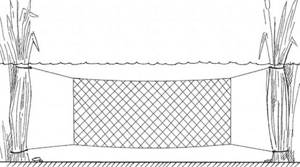
Screen, aka “TV”
The mini-seine received this nickname because of the rectangular frame covered with a net. In a number of republics of the USSR, fishing in what was for some reason called a barbaric method was equated with poaching.

The method is still viable today; it is used in Russia by both adults and teenagers. But it's still illegal. Although such a catch is of neither commercial value nor for resale.
Stages of making a fishing screen
Next, let's look at the process of making a fishing screen.
- To make a fishing screen, you will need a square or rectangular frame. You can choose the sizes by eye. The dimensions depend on the depth of the pond and the place where you are going to throw it.
- The float or the top of the screen is made from a bamboo or wooden stick, which must be painted with varnish. This process is necessary to ensure that the wooden structure does not swell in water. You can, of course, not varnish, but this can subsequently destroy the structure. The weight or lower part must be made of heavy materials to immerse the screen to the bottom of the reservoir. For the lower part of the fishing screen, you can use a metal rod. Then we cut the mesh fabric to the size of the prepared frame in the lower and upper parts of the fabric and pull the cord. This must be done on each cell or at least every other one.
- When you have a prepared frame, you need to attach a mesh fabric to it using a strong thread. This is done in the following steps: first we fasten the end of the thread to the bamboo stick, then the mesh cell must be tied in other places using thread. And this continues until the mesh fabric is completely attached to our frame. A similar procedure must be done with a metal rod.
- After this, from the side of the canvas we pass the prepared thread in the form of a spiral, starting from the stick and ending with the rod, while not skipping a single cell. This is necessary in order to relieve the tension of the mesh under water, and when raising the mesh to the surface of the water.
- We attach a cord to the stick in the middle, then attach a float to it, for the manufacture of which foam plastic was used. The presence of a float is necessary in order to know where the fishing screen is located.
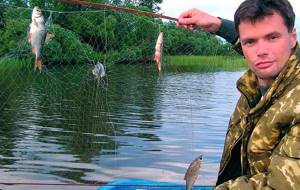
When fishing with a fishing screen, it’s worth knowing a few tricks, which we’ll look at below. The size of fish caught depends on the size of the mesh used. When using an 18 mm mesh, you catch a small fish that is suitable for bait when hunting a predator. If you use a 24 mm mesh, then there is a chance of catching big fish. Whatever cell you use, you always need to feed the fish, then you will get a good catch for fish soup and a wonderful outdoor recreation.
Screen installation
There are several ways to install gear in the water: from the shore, from a boat, from a bridge, from a dam, etc. The most acceptable method is installation from a boat, since you can install a “TV” at any point in the reservoir and the fishing efficiency increases by an order of magnitude.
In the case of casting from the shore, fishing screens are equipped with long wooden poles, and in the case of installing several screens, you can use one pole with a hook at the end, which would allow you to pick up a fishing line or cord installed in the screen’s pond.
Fishing TV and fishing screen are prohibited by law
Dear fishermen! Earlier on this page there was an article about how to make a TV for fishing or a fishing screen with your own hands . But due to the fact that this type of fishing is prohibited by the law of the Russian Federation, we received a letter with the following content:
In accordance with Part 7 of Article 15.1 of the Federal Law of July 27, 2006 No. 149-FZ “On Information, Information Technologies and Information Protection,” we notify that on the basis of a decision of the court/authorized federal executive body (Stanovlyansky District Court - Lipetsk Region) dated December 19 .2018 No. 2a-407/2018 site page index on the Internet https://rybsoveti.ru/rybolovnyj-televizor.html is included in the “Unified Register of domain names, site page indexes on the Internet and network addresses that allow identify sites on the Internet containing information the distribution of which is prohibited in the Russian Federation,” registration number 607031-RI due to the fact that this information contains information the distribution of which in the Russian Federation is prohibited by a court decision.
Information is posted on the method of manufacturing and modernizing a fishing “TV”, which is a prohibited fishing gear and a method of mass destruction of biological resources, recognized as prohibited on the territory of the Russian Federation.
Screen or TV

Among the numerous fishing tools, there are also those that are so simple that they do not require special skills or abilities. Such tools also include a screen or, as it is also called, a TV for fishing.
This fishing device consists of the following parts:
- Wooden slats or sealed tube.
- Square or rectangular grid.
- Metal rod-weight.
- Cord.
- Float.
As you can see, there is nothing complicated in this gear and it is easy to make with your own hands.
Fishing on the screen is easy and simple. It is enough to throw it into the intended place of parking or feeding of fish and after a while take it out with the catch.
Despite the fact that the tackle is considered poaching, the parts for its manufacture can be purchased at the store and made by yourself. This will not take much of the fisherman's time.
What is a fishing TV:
- A fishing TV is a rectangular or square frame. Its dimensions are usually 1.5 by 1.5 meters or 1.5 meters long and 1.0 meter wide, depending on the depth of the reservoir at the point of casting. Many craftsmen select sizes that correspond to places they have already looked at.
- The upper part of the TV (float) is an ordinary wooden slat or bamboo stick, one and a half meters long. Varnished so that it swells less in water. The lower part (weight) is a heavier material so that the screen sinks to the bottom. Most often this is a metal rod.
- On the finished frame, the mesh fabric is secured with a strong thread. At the beginning of the bamboo stick or slats, one end of the thread is fixed, the mesh cells are tied in several places with nylon thread to the end of the slats. Same with a metal rod.
- In the side part of the canvas there is a nylon thread or cord in a spiral from a bamboo stick to a metal rod, without missing a single cell.
- A cord or nylon thread is tied in the middle of the top wooden rail, to which a foam float is attached so that the place on the surface of the water where the fishing TV is installed can be seen. A mesh made from a fishing line is considered more catchy than one made from silk thread or twisted rope, but the service life of a mesh made from a fishing line is less than that of a mesh fabric.
The size of the mesh determines the size of the fish caught; if the mesh is 18 mm, then this is a medium-sized catch, such a fish will be good as bait for a predator. And if it is 24 mm, then it will be larger. Whatever method you fish, do not forget to feed the fishing spots. Then your fishing trip will end with an excellent fish soup and a wonderful dinner in nature. Please do not use prohibited fishing methods such as fishing TV or fishing screen.
DIY fishing screen
Some fishermen fundamentally fish exclusively with fishing rods for their own pleasure. And others prefer not to strain and use a screen for fishing, which is easy to manufacture and use, and is also inexpensive. From this article you will learn how to make a fishing screen with your own hands, because many fishermen prefer to make a fishing screen with their own hands.
A fishing screen is a popular rectangular or square-shaped device that belongs to handicraft fishing tools. Because of its shape, it is also called the “fishing TV”. The fishing screen allows you to catch fish without difficulty, especially small ones (for bait).
Fishing screens are best installed on reservoirs, ponds, and rivers where there is no current, especially on warm spring and summer days. But this does not mean that you cannot fish this way in winter. There is a so-called fishing scarf, the principle of its manufacture is the same, but it has a triangular shape, which is lowered into the hole and a float is used as a wooden block.
Fishing screen
You can install such gear in two ways:
- on open water from a boat or boat;
- near the shore, from a bridge, from a dam.
It is much easier to catch fish from a boat, since you can choose any fishing spot in a body of water and calmly throw the tackle behind a strong thread with a float. In any case, installing a TV from a boat will be more effective than from the shore due to the reeds. You have to additionally make a wooden pole with a rope. Attach a hook to the end of the rope that could catch on a fishing line or cord floating in the water, and thus retrieve the TV.
Legality of fishing
Fishermen are fined for using fishing screens. Although this method does not provide for a large catch of fish, as with the help of other gear or nets, the regulatory authorities still strictly monitor the conservation of most species of fish. Sometimes fishermen think that since they have small home-made fishing TVs, this does not concern them. But everyone should remember that during the spawning period they should refrain from fishing. During this period, prepare all your supplies in order for the new season.
Screen device
Instructions for making a fishing screen
Every real fisherman will sooner or later think about how to make a TV for fishing with his own hands. For this he will need the following materials:
- float made of lightweight material (foam);
- plastic tube, wooden block (bamboo stick);
- mesh fabric;
- cargo (metal rods);
- fishing line, nylon threads, cord.
Let's take a closer look at the step-by-step instructions on how to make a fishing screen:
- Typically the width and length of a fishing TV is 1.5 meters. But depending on the depth of the reservoir, the length of the screen is sometimes increased;
- When making the upper part (float), a sealed plastic tube or a flat wooden block coated with waterproof varnish or paint is used;
- A weight made of metal rods is used as the lower part so that the screen can be easily lowered to the bottom of the reservoir. Some fishermen additionally attach bait in the center of the screen;
- The next step is to prepare the mesh fabric, which should match the size of the frame. The cell sizes of the mesh fabric depend on the purpose and use of such equipment. As a rule, they have sizes from 15 to 50 mm;
- The finished mesh fabric is attached to the top and bottom of the frame using a strong nylon thread that passes through each mesh cell. To effectively catch fish, the mesh should be made of thin, high-quality threads so that the screen is not visible in the water, and also should not be pulled too tightly over the metal frame;
- On both sides of the upper part of the frame, two nylon or fishing line rods are attached, which smoothly turn into a cord or thick fishing line no smaller than 0.7 mm in size, at the tip of which a foam float is attached, floating on the surface of the water. This is necessary in order to determine the location of the TV and find out whether the fish was caught;
- This DIY fishing screen is ready for use. Although such tackle is not durable, it does not cause harm to other fish and does not pollute water resources.
Source
Published on December 5, 2016 at 07:00
handf.mirtesen.ru
Why is it prohibited to use a fishing TV:
- Refers to methods of mass destruction of biological resources
- It kills the fish if it is in the water without the supervision of a fisherman, that is, if your fishing screen is carried away by the current, a huge number of fish will suffer, it simply gets stuck and rots alive.
Which methods of installing fishing screens are prohibited:
- From the shore, when a rope is tied to a stick or pole, with the help of which, after the catch, you can deliver the TV to the shore.
- From the boat, when the fishing screen is lowered by a nylon thread with a float to the desired installation location.
- Other, all kinds of ways to set up screens and fish in open water.
It is also prohibited to fish in holes in winter, but fishing scarves are more often used for this method. The scarf is similar to a TV, but the canvas has a triangular shape and instead of a wooden slat, a float is installed at the top point.
Attention! Fishing TVs and screens are prohibited by Russian law.

Long casting rod with sliding float
Legality of fishing
Fishing using such methods is prohibited throughout Russia, although “TVs” do not have any particular catchability and are inferior to such gear as nets or bottom fishing. Despite the ban, fishing with such folk nets continues to this day.
Fishermen are fined for fishing on TV. Although this method does not provide for a large catch of fish, as with the help of other gear or nets, the regulatory authorities still strictly monitor the conservation of most species of fish.
Sometimes fishermen think that since they have small home-made fishing TVs, this does not concern them. But everyone should remember that during the spawning period they should refrain from fishing.
During this period, prepare all your supplies in order for the new season.
Winter fishing with nets and screens
Winter fishing with nets and screens
Types of networks, their design and components
In the central, most densely populated regions of Russia, amateur fishing with nets is practically undeveloped: in some places it is prohibited, in others obtaining a permit involves a disproportionate amount of time or money... In addition, installing nets in winter requires much more labor. In the summer it’s easier, in the summer you can quickly and easily lower a cheap Chinese net into a pond, without worrying about the permitting paper with a stamp - the fisheries inspection will be caught with a “cat”, you can unlock it: I’m not me, the net is not mine; If it doesn’t hook you, an increase in what you catch with the fishing rod is guaranteed. Many fishermen in the central regions are guilty of this - not out of self-interest and not out of a desire to destroy all life in the reservoirs where they themselves fish. An insurance policy against biting, nothing more.
How to fish correctly on the screen
One of the most popular devices (it’s no longer correct to call it gear) for fishing is the “screen”; people often call it a word like “TV”. The simplicity of the design, the ability to assemble it yourself, the low cost of purchase (for example, in my region they offer screens from 250 rubles per product) this attracts fishermen to this product.
Now let's talk about ease of use. It would seem that throw the screen into the water and wait for the catch.
Of course, after securing it to the shore. However, screen fishing also has its “secrets”.
Screen for ice fishing
Fishing screen (TV) “FAVORABLE”, cell 25mm; size (1.2*0.9m) Mesh fabric - China; 0.15mm di..
Fishing screen (TV) “FAVORABLE”, cell 27mm; size (1.2*0.9m) Mesh fabric - China; 0.15mm di..
Fishing screen (TV) “FAVORABLE”, cell 30mm; size (1.2*0.9m) Mesh fabric - China; 0.17mm di..
Screen (TV) fishing “FAVORABLE”, cell 35mm; size (1.2*0.9m) Mesh fabric - China; 0.17mm di..
Fishing screen (TV) “FAVORABLE”, cell 40mm; size (1.2*0.9m) Mesh fabric - China; 0.20mm di..
Fishing screen (TV) “FAVORABLE”, cell 45mm; size (1.2*0.9m) Mesh fabric - China; 0.20mm di..
Fishing screen (TV) “FAVORABLE”, cell 50mm; size (1.2*0.9m) Mesh fabric - China; 0.20mm di..
Fishing screen (TV) “OPTIMAL”, cell 8mm; size (1.2*0.9 m) Mesh fabric - Crayfish; 0.15..
Fishing screen (TV) “OPTIMAL”, cell 10mm; size (1.2*0.8m) Mesh fabric - Crayfish;0.1..
Fishing screen (TV) “OPTIMAL”, cell 12mm; size (1.2*0.8m) Mesh fabric - Crayfish;0.1..
Fishing screen (TV) “OPTIMAL”, cell 13mm; size (1.2*0.8m) Mesh fabric - Crayfish;0.1..
Fishing screen (TV) “OPTIMAL”, cell 14mm; size (1.2*0.8m) Mesh fabric - Crayfish;0.1..
Tactics and fishing techniques
There are no special secrets to how to use a fishing screen. “TV” is not the fisherman’s main tool, but performs only an auxiliary function: catching live bait on a predator, catching small things to prevent unwanted bites and catching small things to attract predatory fish. The screen also helps catch fish on the ear and is only used as a last resort for catching trophy fish.
How to equip and use the fishing screen:
- Elements are tied in the center or along the edges to attract attention: a garland, a bait;
- installed on “fish paths” where prey constantly moves;
- thrown in the gap between the algae;
- hooks along the edges of the screen cannot be used, otherwise there is a high risk of snagging and stuck fish will scare away other peace-loving relatives;
- when knitting a mesh, it is better to use a thin fishing line that is invisible to the fish eye;
- You should not use wooden sticks as a frame, as they float and you have to install a heavy weight.
There are no special secrets to using the fishing screen
Fishing screens: types
There are several options to choose from:
Economy is a budget option for fishing TV, which will be purchased by those who plan to buy cheap fishing screens. Simple equipment and low cost are its priority indicators.
Optimal - the fishing screen has high quality materials and is distinguished by the use of special anti-corrosion (for the rod) and moisture-proof (for the slats) compounds in the process of preparing the screen elements.
Frame is a fishing tackle screen similar to a framed mesh. The main advantage is better fishing efficiency due to the operation of the screen pockets. You can buy line and nylon fishing screens in stock.
The exclusive one contains a twisted mesh fabric. It is distinguished by increased strength indicators that can withstand any catch.
Sending custom-made fishing screens is possible in any quantity. We offer to submit applications for several types of screens at once. This will allow you to understand the operation of the screens from your own experience and subsequently specifically order the desired fishing TV.
Screen making
As already mentioned, the net is bought at a fishing store or a piece is cut off from an old unnecessary net. You also need to find a wooden strip and a metal rod.
In addition, to make a screen with your own hands you need to have on hand:
- roulette;
- scissors and knife;
- twine or thick fishing line;
You immediately need to decide on the size of the TV. Usually its dimensions are no larger than 1.5 by 1.5 meters. In addition, you need to choose the mesh size, which should match the fish you plan to catch.
When starting to make a TV, you first need to cut the rail to the size of the mesh. After this, mark at regular intervals on the rail the points at which the screen “display” will be attached. The rod at the bottom of the TV should be equal in length to the rail.
Having drilled holes at the ends of the rail, we attach the mesh to it using fishing line or strong synthetic thread. Then we attach the rod to the bottom of the net using fishing line. Some people use PVC tape to secure the net.
We tie a strong twine or thick fishing line to the holes in the ends of the slats so that the made screen hangs on it. In the middle of this twine we knit a cord, at the end of which a large foam float is attached. It is needed to indicate the location of the TV, as well as to control the presence of fish on the screen.
Here's how to make a TV for fishing with your own hands - simply and at a minimum cost.
Making crayfish shells from improvised materials with your own hands
Crayfish boiled in salted water with seasonings is an excellent appetizer for a foamy drink.
But many beer drinkers are simply lazy or don’t know how to catch them. This is partly due to the fact that there is no fishing gear - a rachevnya, or crayfish trap. In this article we will tell you how to make a crayfish trap with your own hands and how best to attach bait in it. We will also briefly give examples of baits for catching crayfish and indicate the best places to install traps.
Types of crayfish
There are open and closed shells, both of which can be made at home. Here is a short list of the different designs:
- plastic bottle trap;
- screen;
- inkwell;
- top;
- umbrella.
We will describe the production of some of these cures in this article.
From the bottle
The simplest and fastest version of a homemade soup can be easily made from such a popular material among all our homemade crafters as a plastic bottle. To make a trap we will need:
- five liter plastic bottle;
- soft wire or thick fishing line;
- rope;
- cargo;
- awl;
- knife and scissors.
We give a description of how to make a crayfish trap using the above materials and tools:
- Cut off the top part with the neck of the plastic bottle.
- I also cut the neck itself so that there is a hole through which the crayfish can fit.
- We turn the upper part over and insert it into the lower half with the tapering end inward, so it is easy for the cancer to get inside, but then difficult to get out of the trap.
- We connect the two halves. You can knit them together using fishing line or wire threaded through holes made with an awl.
- We make large holes in the main part of the bottle to release air.
- We attach some kind of weight to the bottom to prevent the trap from floating up.
- We knit a loop from the inside to the bottom to attach the bait.
- We tie a rope to the junction of the trap parts.
On the pond you need to untie the wire connecting the two parts of the crayfish and strengthen the bait. Then you need to tie both halves again. After that, holding the homemade trap by the rope, we throw the trap into the selected place of the reservoir. Using a cord, we fix the ravine on the shore to a driven peg or a growing bush or tree.
In the form of a top
This design resembles the previous model in the way the crayfish enter it through a tapering cone. It is best made from metal fine mesh. Let's describe how to make a clamshell of this type:
- Cut a strip of mesh about a meter wide. This piece can be from one and a half to two and a half meters long; a longer trap will be difficult to throw and pull out.
- We roll the strip into a cylinder, the diameter of its base will be about thirty centimeters.
- We tie the edges of the strip together using tying wire or welding.
- From the same mesh we form two conical entrances.
- We attach them with the narrow side to the base of the cylinder using wire.
- We tie the narrow ends of the cones together inside the trap with three wire ties.
- We tie ropes to one or both ends.
Bait is placed in the trap, then the top is thrown onto the crayfish or brought into the water, depending on its size. There is no need to weigh it down, since the metal mesh adheres well to the bottom.
Screens are called lift-type traps with a mesh stretched over a metal frame. They are also easy to make at home. For this we need:
- strong elastic steel wire with a diameter of 4-6 millimeters;
- mesh with small cells;
- cord.
To make a shell out of this, you need to do the following:
- We bend the wire into a circle with a diameter of about fifty centimeters. For this we need a piece 1.5-1.6 meters long.
- We weld the ends of the wire or tie them with binding wire.
- We stretch the net over the resulting hoop. The tension should not be tight so that the net sags a little in the center.
- We tie four laces of equal length to the hoop, the segments should be approximately 40-50 centimeters.
- We tie the second ends of the laces together.
- We attach a rope to a common knot.
At the pond we tie the rope to a long, strong pole. We place a weight in the middle of the screen and tie a bait placed in a bag made of rare fabric. It could be:
- tulle;
- gauze;
- Women's tights, maybe not new.
We lower the crayfish trap into the water and wait for the crayfish. This trap needs to be checked every 20-30 minutes. We pull out the crayfish vertically, while the weight helps to pull the bottom, preventing the prey from quickly leaving the crayfish.
Inkwell
If you improve the previous trap a little, you can make an ink trap. It received this name because of its resemblance to the non-spill inkwell, which was used by Soviet schoolchildren when writing with a fountain pen.
To upgrade, we will need to bend another ring, using a piece of wire one meter long. It is easy to calculate that the diameter of the small ring will be about thirty centimeters. Next we do this:
- We take the bottom with the mesh stretched over it from the previous design.
- We connect the bottom to the ring using three or four knitting needles, 20-30 centimeters high. Welding electrodes are great for this. The result was a design in the form of a wire truncated cone.
- We stretch the mesh over the sides of the cone.
- We tie laces to the small upper ring; they can also be secured to the bottom, and simply crossed over the small hoop.
- We connect the laces together and tie a rope to them.
On a pond we equip the inkwell in the same way as the screen. But thanks to the high sides, it is difficult for crayfish to get out of it, so you can leave such a trap without pulling it out for a much longer period, from two to six hours.
Application
Regardless of the design, all crayfish traps use the same type of bait. To attract crayfish into the trap, the following baits are used:
- fish cutting;
- fresh fish;
- chicken and rabbit offal;
- pet liver;
- bread with garlic or dill.
They install crayfish traps near steep, washed-out shores. It is desirable that the bottom in this place be clayey or bordering on stones. It is in this soil that crayfish make their burrows.
Where and how to use the screen
Fishing on a TV is not particularly difficult. It is best to place the screen from a boat, although you can throw it into the water from the shore. To do this, you can use a kind of “rod” from any suitable twig or branch.
The gear is placed at the place of feeding or migration of fish, at the border of aquatic vegetation, in small channels, etc. To attract fish to the TV, some anglers tie some kind of bait in the center of the screen: a piece of cake, a small bag of bread, porridge, etc.
There is a more original way to lure fish into a net. This is ordinary Christmas tree tinsel, pieces of which are tied in different places on the grid and attract fish with their shine. In this way you can catch predatory fish.
It must be remembered that gear called “TV” or “screen” is considered poaching, and the angler using it can be fined.
Considering these reasons, we can confidently say that fishing using a screen will be used in Russian reservoirs for a long time.
Correctly place screens on fish
A fishing screen (TV) is a small fixed net, usually 1.5-2 meters in length. Its design is very simple: instead of a floating cord, a wooden block (dried and treated with a moisture-proofing compound) is used, and instead of a cargo cord, a metal rod (painted with waterproof paint or galvanized) is used.
The net fabric is attached to the block and rod of the fishing screen (TV) using a strong thread. Each cell of the fabric is tied to a bar and rod in a spiral. From bar to bar, the thread is threaded into each cell and pulled out in a straight line. The length of the thread between the bar and the rod depends on the height of the fishing screen (TV) and can be from 0.7 to 1.5 meters. At the ends of the bar and the metal rod of the fishing screen, at a distance of 5-10 mm from the ends on both sides, circular grooves are made for securing the ends of the screen and thread. It is not recommended to use electrical tape or adhesive tape for these purposes, because They come off after being in water for a long time. A fishing line can be attached to a fishing screen (TV) with a float that is in working position on the surface of the water and indicates that the screen has caught a fish.
Like fixed nets, fishing screens (TVs) can be double-walled, triple-walled or framed, but most often they fish according to the principle of a single-walled gill net.
The mesh size of the net can range from 15 mm (for catching live bait) to 45 mm (for catching large fish).
Fishing screens (TVs) are usually installed in two ways: lowered on a fishing line or rope from boats, bridges, dams, or thrown from the shore. From the shore, screens are mainly cast by hand with a rope or fishing line tied to a wooden block, which is previously laid out in a snake on the shore. The other end of the rope or fishing line is tied to a wooden peg, which is stuck into the bank. If you are installing several fishing screens (TVs), be sure to mark in some way the place where the pegs are located so that they are easy to find later.
A fishing screen (TV) is rarely used as an independent tackle; it usually performs auxiliary functions when fishing. For example, lovers of catching burbot on bottoms and subs very often set up a couple of fine-mesh screens for catching live bait. Floaters also sometimes place screens near the fishing site to protect themselves from no bite. In addition, the screen allows you to diversify the catch - for example, when fishing for white fish with a vegetable bait, you can place two or three screens where the small perch chases.
A fishing screen (TV) can be used as an independent tackle in places where there is a lot of fish, or they can use fish from a boat (mainly in ponds), or they can put many screens in different places.
Installing fishing screens (TVs) on the path of the spring fish movement can be quite catchy, but to do this you need to have a very good idea of where the “fish paths” lie in the reservoir - just miss by a few meters, and the “TV” will remain empty.
Sometimes anglers try to lure fish to the screens by attaching cake baits or capsules with aromatic oily substances to the sinker. It is difficult to assess the effectiveness of such methods; sometimes the catch is pleasing, sometimes not a single fish hits the screen.
Catching Fish on Screens in the Snezheti River [Fishing on Screen Video]
Where can I get funds for cool fishing? THE ANSWER IS HERE!!! CLICK HERE -
installation of fishing gear preparation of bait feeder fishing foam fishing Fishing (TV Genre) fishing with feeders fishing gear fishing films fishing for carp feeder is just fishing Ivano-Frankivsk carp on a spinning feeder tackle fishing for crucian carp Ivano-Frankivsk carp with a rod fishing with a feeder carp on the feeder bottom tackle fishing in spring running donka big fish carp fishing carp fishing carp carp landing net catch fish paternoster feeder fishing feeder carp fishing silver carp bait hook Ukraine fishing fishing bait Dnister Ukraine crucian carp fish colmic dunaev spawning Bushtin Dniester Russia Russia donka carp Feeder diversion lake fishing la fish Amur 2013 biting river Zhor catfish feeder fishing bream
Fishing with Poppers - Training, Tips [Fishing with Poppers]Where can I get funds for cool fishing? THE ANSWER IS HERE!!! CLICK HERE -
Popla - popper.
Fishing with Kalmykov surface lures catching pike with a popper Siberian fishing popper Savage Gear fishing with a popper fishing in the spring winter fishing in Siberia “how to do it right” fishing with a popper pike with a popper summer fishing “how to catch” types of lures with a spinning rod Shcherbakovs “how to catch” fishing for pike Fishing pike about fishing fishing pike popper spinning rod spinning on wobblers fishing brothers "video about" fish on a wobbler for fishing correctly topwaters in the spring World of Catch catch spring video on the river fishing wolves in the fall early tackle wolfer predator on poppers catch in the summer winter catch Fish pike fishing fishing
fishing rod for winter fishing without a blood jig winter fishing perch winter fishing perch fishing in winter fishing for pike perch winter fishing with a jig fishing in December perch fishing winter pike fishing in winter bream fishing in winter perch fishing carp fishing fishing for devils fishing for devils pike fishing winter winter fishing la bream fishing for pike fishing tackle fishing with the devil winter fishing Winter fishing Master class winter fishing rod fishing in winter fishing devil devil fishing perch Petrovich fishing fishing catfish Gennadievich bezmotylka fishing in winter without bait p. Kilmez jig devil winter fishing Devil devil Ochagov Fishing rod perch pike perch Oleg pike
fishing secrets of the Shcherbakov brothers fish bite forecast fishing for pike with a spinning rod Fishing for crucian carp in winter Fishing without borders trolling fishing fisherman's calendar fishing fun fishing in Russia Siberian fishing fishing Shcherbakovs bite forecast fishing forecast winter fishing fishing with live bait how to catch pike fishing secrets Fish (Animal) Fishing video about biting fish catching perch catching fish about fishing fishing fishing biting fish balancer fishing World of Catch angler machine winter tackle shark car
Watch Traps.
— Vyatel For FishingWhere can I get funds for cool fishing? THE ANSWER IS HERE!!! CLICK HERE -
Animal (Organism Classification) District Council Of Kimba Ecotourism (Film Subject) Tourism (Interest) village tourism rural tourism Vesti-Khabarovsk hunting rifles duck hunting Rural Tourism fishing Khabarovsk video hunting Cat (Animal) Khabarovsk mordushka hunting 2013 preparation Image St. Petersburg tourism rifle ecotourism open hunter fishing Far sea Siandien Fishing weapon cartridge trap badger halt East summer fishing Galina joke LOSEVO gun beaver mink otter hunting hike port 25th exit Kimba video fish Hunting wolf bullet raccoon edge of June sea Kote 941
See F. Fish Fishing Forecast for June 15.
2013 (Ukraine) - Fishing ForecastWhere can I get funds for cool fishing? THE ANSWER IS HERE!!! CLICK HERE -
fishing secrets of the Shcherbakov brothers fishing forecast fish bite forecast Fishing for crucian carp in winter Fishing without borders fisherman's calendar fishing trolling fishing in Ukraine fishing fun fishing in Russia Siberian fishing fishing Shcherbakovs fishing forecast fishing with live bait how to catch pike winter fishing Fish (Animal) about fishing fish catching perch fishing fish biting balancer fishing machine winter shark car
Ryback (Solo Wrestler Or Team) Vershire (City/Town/Village) commercial fishing video fishing with nets video commercial fishing crazy fishing incredible fishing fish jokes about hunting Catching fish this is fishing fishing secrets fishing jokes successful fishing Russian fishing method of fishing fishing with nets fishing fishing video Fish (Animal) fishing fisherman fishermen fish fisherman video dragging hunting gun pitchfork laughter
Dynamite Fishing in Lebanon Dynamite Fishing Video fishing in the Moscow region fishing with spinning fish fishing with spinning fish fishing shop dialogues about fishing hunting with a crossbow fishing tackle winter fishing fishing on the Volga fishing on the Dnieper carp fishing bear hunting wolf hunting wild boar hunting hunting and fishing feeder equipment underwater hunting fishing online Winter fishing Feeder fishing video hare hunting Russian fishing for beginners crucian carp fishing all about fishing fishing video winter fishing rod Blast fishing reservoir roach fishing bream fishing wolf hunting Bream fishing fishing for carp with a jig Dynamite bream fishing Illegal fishing Lebanon bream in winter crucian tackle Fishing bream on the feeder hunting for jigs fishing feeder autumn Lebanon Ruzsky bait river roach colmic dunaev Feeder Tin Fishing fish hunting don
How to weave a TV for fishing
» Articles » How to weave a TV for fishing
Screens are also much cheaper and easier to manufacture and use than networks. The most primitive screen can be made even on a pond, in the field, from a piece of an old net found on the shore.
Once, in my presence, an asp weighing more than 4 kilograms was caught: a piece of a net one and a half meters long and the same height, without any equipment, was stretched around the corners with four fishing lines in a narrow, shallow and fast-flowing channel between reed thickets, where they used to chase small things a large asp that did not allow anyone to approach him with a spinning rod or live bait fishing rod. No one seriously believed in success, but the most primitive tackle worked! The next morning, a large float tied to one of the lines (an antifreeze canister) swayed on the water ten meters downstream, and at the bottom lay an asp, swaddled like a baby.
I don’t even know why fishing regulations pursued this gear so mercilessly for many years.
It is not distinguished by supernatural catchability - in terms of catches, “screeners” have always been inferior not only to “netters”, but also to anglers.
No particular damage to fish populations was observed either; in terms of the impact on the ecosystem of a river or lake, a “TV” compared to, say, a seine is like a sniper’s shot compared to a nuclear explosion.
However, it was prohibited. It came to a paradox: networks in the region are allowed, but “TVs” are persecuted.
Perhaps the whole point is that it is much more difficult for fisheries protection to detect screens placed throughout the reservoir than to hook a net with a “cat” and check for the presence of a tag on it indicating “legality”. (Not to mention the lovers of nonsense, who are always in full view.) But there are plenty of baits for pike and donks for burbot, and it won’t be easy to find them... In general, it’s a mystery.
Rice. 4. “TV” (summer version of fishing line attachment): 1 – float; 2 – mesh fabric; 3 – load; 4 – thrust; 5 – main line.
The “TV” is designed very simply: the same fixed net, only short, 1.5–2 m in length, and the load cord is replaced by a hard long weight (metal rod), and the floating one is replaced by a hard long float (a stick, well dried and several times longer). layers of painted waterproof paint, or a plastic pipe with tightly plugged ends). There are combinations of a rigid sinker with a flexible floating cord and, conversely, a rigid float with a cargo cord.
Two rods are attached to the ends of the float, and to them is a fishing line with a diameter of 0.7 mm, sometimes thicker. A small float can be attached to the fishing line, which is in working position on the surface of the water and signals that a fish is entangled in the screen.
Like fixed nets, “TVs” can be double-walled, three-walled or framed, but most often they are caught on the principle of a single-walled gill net.
The mesh pitch on the mesh fabric can be very different, from 15 mm in designs designed for catching live bait, to 50 mm or more in gear designed for catching large fish.
“TVs” are displayed mainly in two ways: lowered on a fishing line from boats, bridges, dams, or thrown from the shore.
In the latter case, each tackle is attached to a separate pole of the appropriate length, or one pole with a flyer at the end is used, which allows you to pick up the fishing line.
When fishing with one “TV”, you can tie it to the line of a spinning rod or telescopic rod with the whip removed.
“TV” is rarely used as an independent tackle; it usually performs auxiliary tasks when fishing. For example, lovers of catching burbot on bottoms and subs very often set up a couple of fine-mesh screens so as not to be distracted by the fishing of live bait.
Float anglers also often place “TVs” next to the fishing site, insuring themselves against a possible lack of bite.
In addition, the “TV” allows you to diversify the possible prey - for example, when catching scavengers with vegetable bait, you can place two or three screens where the perch chasing the fry splashes, and hook several striped predators, which by definition are not interested in vegetable bait.
Exclusively “TV” fishing, due to the very small area of the gear, is only possible with a surge or in places with a high concentration of fish. In the first case, the fisherman uses no more than 1-2 gear and installs them most often on small but fairly deep steep rivers, perpendicular to the shore.
Then he “botts” - with force he vertically lowers the end of the same pole with which he installed the gear into the water (a neck cut off from a plastic half-liter bottle is tightly put on the pole). Some of the fish, frightened by sharp sounds, become entangled in the screens.
This fishing is popular and quite active, but its lovers can rarely boast of big catches.
Placing screens in the path of the spring fish movement may be much more effective, but to do this you need to know how the “fish paths” run in the reservoir; just miss by a few meters and the “TV” will remain empty.
Some fishermen try to lure fish to the screens by attaching cake baits or capsules with aromatic oily substances to the sinker. It is difficult to assess the effectiveness of such methods; sometimes the catch is pleasing, sometimes not a single fish hits the screen.
Winter, ice fishing with “TVs” is possible, but is used less frequently than fishing with “kerchiefs,” which will be described below. In winter, the fishing line is attached to one end of the sinker and passed through a loop attached to the end of the float.
This gear is very similar in design and principle of operation to a “TV”, the only difference is that its mesh fabric is not rectangular or square, but triangular. The float, accordingly, is not a stick, but a foam cylinder.
It is not difficult to understand that the closer to the bottom a fish stays, the more likely it is to become entangled in a net that narrows upward. Therefore, “kerchiefs” are more often used in winter, when all types of fish huddle close to the bottom.
Rice. 5. “Scarf” (summer option for attaching fishing line)
Some fishermen turn their “TVs” into “kerchiefs” for the winter, replacing the long float with a compact one and pulling together the upper edge of the mesh fabric (such tackle is easier to pull into the hole).
In places where roach or perch are concentrated in winter, “scarfs” can be very catchy, especially in the first ice, when the fish are still quite actively moving. In the dead of winter, catches fall, increasing with spring thaws.
I’m afraid that the next generation of fishermen will not be able to determine where the name of this gear comes from.
But for those who in childhood tied a scarlet tie made of artificial silk around their neck every morning, such a question does not arise - the “pioneer” is exactly this item of clothing.
In fact, this is a small “scarf” - an isosceles triangle (base 50–60 cm, height 25–30 cm, other proportions are possible), cut from net fabric.
However, the “pioneer” is a highly specialized tackle; fishing with it has a number of features, which is why it is worth talking about it separately.
The “pioneer” is intended only for catching large bleak. The net is used from monofilament, with a mesh size of 15–18 mm; At the top, close to the net, a large egg-shaped float made of white foam plastic (not painted, since white plays an important role in fishing) is placed. The sinker is made of thick aluminum wire, and its weight is not capable of sinking the float.
Fishing is mainly done from bridges, embankments, dams - in those places where large (more than 15 cm) bleak is found in sufficient quantities.
If the distance to the water allows, then the “pioneer” is attached with a thick fishing line to the pole, so that the tackle can be lifted up in one movement.
If it is too high, then use a rigid spinning rod with a reel, or a telescopic rod with the upper legs removed.
Source:
Fishing with a screen
» Articles about fishing » Fishing with a screen
A fishing screen, or “TV” as it is popularly called, belongs to handicraft fishing gear and is very popular due to its ease of manufacture and use.
Despite its primitiveness, this tackle can catch all types of peaceful fish, and of various sizes - from small ones, which are used as live bait, to normal-sized fish, which is not shameful to put on the table fried.
This simple device, popularly called a “TV,” has almost standard dimensions of 1.5 x 1.5 m and resembles a rectangular shape. A metal rod is used as a load, from which, in fact, the frame is welded, although you can find (and much more often) collapsible versions of the “TV.” Instead of a floating cord, a wooden stick is used.
It must be thoroughly dried and coated with waterproof varnish or paint. You can use a plastic tube, closed on both sides with plugs, for tightness.
Based on the fact that the gear is folk and there is a lot of room for imagination, you can find completely different options for design solutions, but the meaning of this gear and the principle of fishing are absolutely identical.
The stick acts as a kind of float, and 2 rods are attached to its ends, to which a cord or thick fishing line (0.7-1mm) is attached. To signal that a fish is entangled in the “TV”, a float is attached to a cord or fishing line, which is always located on the surface of the water.
Fishing screens are mainly manufactured in single-walled versions, and their operating principle is similar to the operation of a single-walled gill net. Despite this, craftsmen make two-, three-wall, and also frame versions.
The mesh, which is used in the designs of “TVs,” can have cell sizes from 15 to 50 mm, depending on its purpose. To catch live bait, a woven mesh with a minimum mesh size is used.
Legality of fishing
Fishing using such methods is prohibited throughout Russia, although “TVs” do not have any particular catchability and are inferior to such gear as nets or bottom fishing. Despite the ban, fishing with such folk nets continues to this day.
Screen installation
There are several ways to install gear in the water: from the shore, from a boat, from a bridge, from a dam, etc. The most acceptable method is installation from a boat, since you can install a “TV” at any point in the reservoir and the fishing efficiency increases by an order of magnitude.
In the case of casting from the shore, fishing screens are equipped with long wooden poles, and in the case of installing several screens, you can use one pole with a hook at the end, which would allow you to pick up a fishing line or cord installed in the screen’s pond.
Using bait
To further lure fish to the screen, many fishermen use bait, which is fixed near the sinker, in the center of the screen. This can be sunflower cake or complex bait using aromatic additives. It is possible to use bait when it is simply scattered around the “TV”.
Fishing periods
As a rule, fishing screens are used in the summer, when nothing interferes with their installation. They are installed on ponds, bays, and river backwaters, but using screens on currents is quite problematic.
In conclusion, I would like to say that fishing screens are part of passive fishing, which many fishermen fundamentally cannot stand, preferring active types of fishing, as well as fishing with float rods or feeder gear.
Fishing with a screen -
Source: https://pochinka-tv.ru/stati/kak-plesti-televizor-dlya-rybalki.html

